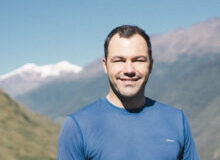Insider’s Guide to Chile & Patagonia: When To Get the Best Value
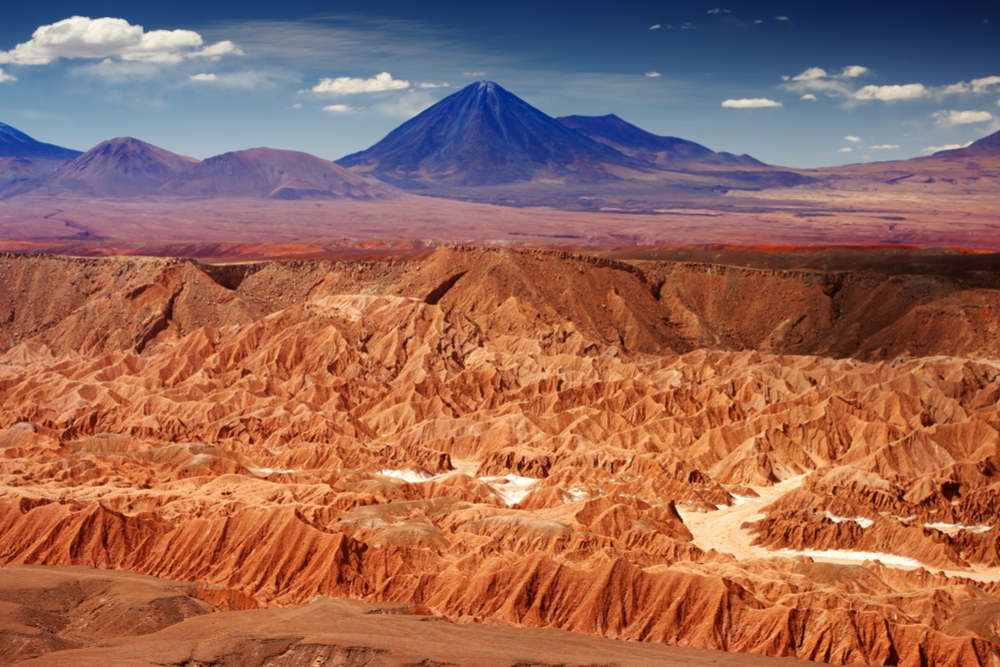 The Atacama Desert in Chile has a beautiful—and otherworldly—landscape. Photo: Shutterstock
The Atacama Desert in Chile has a beautiful—and otherworldly—landscape. Photo: Shutterstock
The insider travel advice on this page is from one of Wendy’s Trusted Travel Experts for Chile: Jordan Harvey of Knowmad Adventures.
Jordan’s love affair with South America began with a high school study-abroad program in Chile. Recognizing the potential of Patagonia before it hit most travelers’ radar, he developed the contacts—winemakers, true-blue gauchos, indigenous families—that now give travelers a deeply authentic experience of Chile and Argentina, from Salta’s gorgeously rainbow-hued scenery to Easter Island’s mysterious moai. Jordan loves juxtaposing the several sides of Chile—the driest desert in the world, the temperate rainforest, and the vast Patagonian landscape—and combining awe-inspiring lodges with remote agritourism enterprises. His background as a wilderness guide gives him an edge in picking the best adventure experiences, from stand-up paddle boarding on blissfully empty lakes to horseback riding past jagged peaks and icy glaciers.
What to See and Do
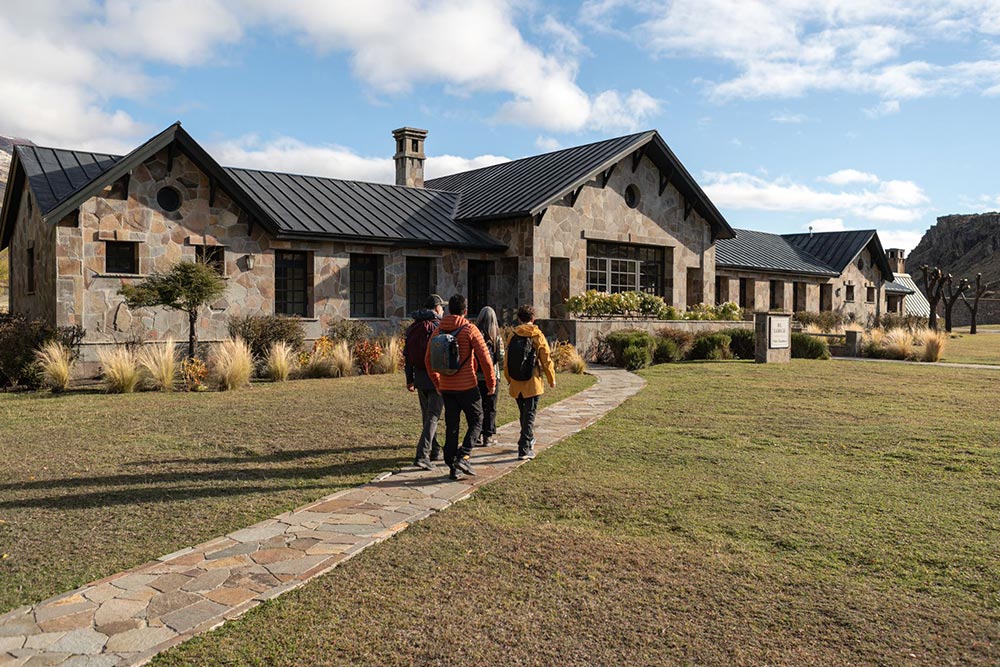
The Explora lodge in Patagonia National Park, part of Chile’s Aysen region. Photo: Explora
Most underrated places
The Aysen region. Aysen comprises the areas south of the Lakes District but north of Torres del Paine/Punta Arenas. It’s arguably one of the most beautiful parts of Patagonia, if not the world. Its complicated access (there are flights from Santiago and Puerto Montt to Balmaceda airport) makes it very difficult to fluidly connect the region to Torres del Paine, which has kept it a backpackers’ paradise. However, the lodging infrastructure has improved greatly near the Marble Caves and San Rafael Glacier, and you can continue on for a five-star experience at Explora’s new lodge in what is the Douglas Tomkins Foundation’s crowning achievement, Parque Patagonia. Weekly charter flights from there to Explora Torres del Paine allow you to finally experience both of these Patagonian gems on the same trip without a bunch of inconvenient flight logistics.
Pucon itself is overrated, but the Lakes District as a whole should be on more travelers’ radar. With turquoise rivers, abundant lakes, lush temperate rainforests, and photogenic volcanoes, the area around Puerto Varas—a less-developed Pucon—is a nature- and adventure-lover’s paradise: Here you can raft the Petrohue River, take light hikes among ancient alerce trees, visit volcanically formed waterfalls, experience a small-town blend of German and Chilean cultures and architecture, and walk back in time by exploring the islands that make up the Chiloe Archipelago (which has its own mystical traditions and maritime culture that are quite disparate from the mainland’s). Futangue Lodge, situated within its own private reserve, offers a five-star experience at a much lower price point then its Torres del Paine counterparts.
Wine Country. Food and wine are integral to Chilean culture. There are several valleys within driving distance of Santiago that produce wines of excellent quality—and value. As for places to stay, Apalta Residence does luxury wine-country experiences every bit as well as you’ll find in better-known areas such as Argentina’s Mendoza region. For a dash of wine country and relaxation, the colonial mansion of Casa Real at Santa Rita lies only an hour or so from the airport, making it ideal after Patagonia but before returning home.
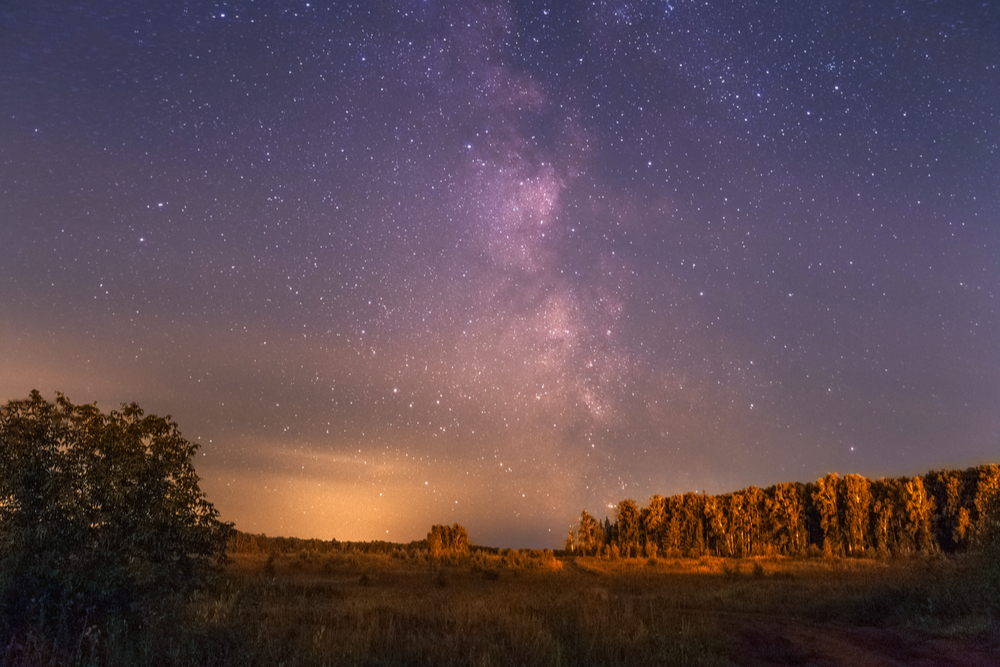
The Atacama Desert’s low humidity and light pollution make it a great spot for stargazing. Photo: Shutterstock
The Atacama Desert. Imagine the surreal landscapes of the American Southwest mixed with the oddities and vastness of Yellowstone (both sit atop super volcanoes) and the indigenous cultures of Bolivia; throw in a dash of Mars and the clearest night sky on the planet, and you have the Atacama Desert. Hike through a sandstone canyon to the natural crystalline Puritama hot springs, photograph flamingos in the salt flats, and take in the sunrise as the Tatio Geyser erupts.
Easter Island. Situated 2,000 miles off Chile’s coast, many travelers don’t realize that Rapa Nui (Easter Island) is a part of Chile and that Santiago is your jumping-off point. Examine cave petroglyphs, discover deserted beaches, and hike amongst the Moai to the top of ancient craters for endless ocean views while searching for answers in this cultural and historical tropical paradise.
Most overrated place
Pucon figures prominently in guidebooks as a flagship adventure destination in the Lakes District, but it’s overdeveloped and crowded.
Hidden gem
Lastarria is a historic Santiago neighborhood; its pedestrian mall is home to great shops and restaurants such as Bocanariz and Café Lastarria, and it’s situated a stone’s throw from Parque Forestal (the city’s largest park) and the Bellas Artes Fine Arts Museum. Have an ice cream at the beloved Emporio la Rosa (Chileans are passionate about their ice cream), or visit San Cristobal Hill to see the local lovebirds and take in sweeping views of the city. The stylish boutique hotels you’ll find in Lastarria are an alternative to the more whitewashed business districts of Los Condes, and they make Santiago a much more user-friendly, intimate destination where you can get a feel for modern-day Chilean life.
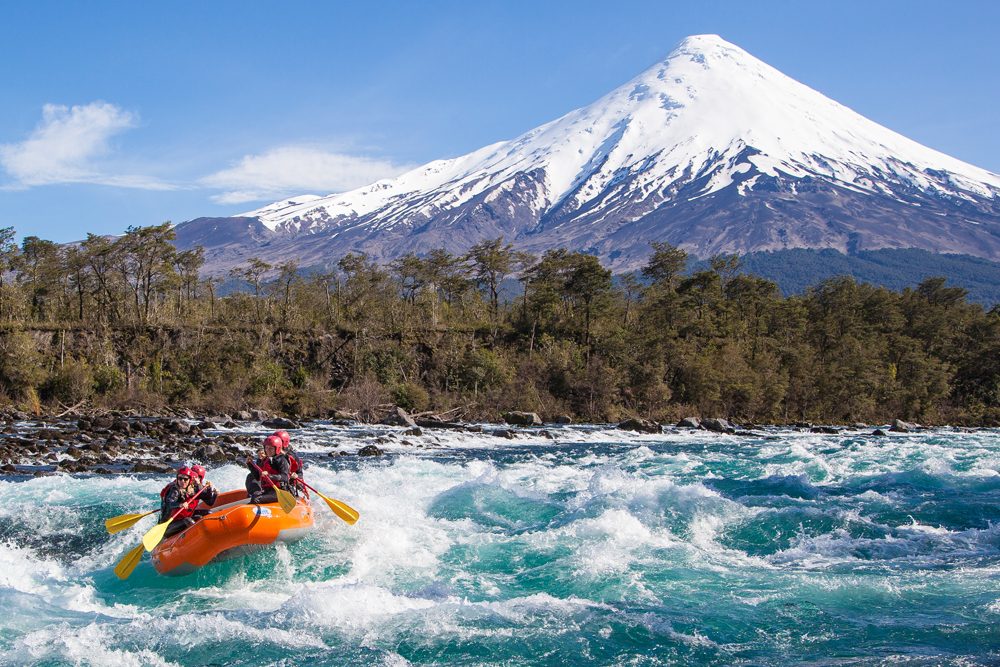
A rafting trip down the Petrohue River suits everyone from whitewater novices to veterans. Photo: Ko Kayak
Cheap thrill
In the Lakes District, take a half-day rafting trip down the Petrohue River—a turquoise gem from which you can see four volcanoes on a clear day. While it’s not at all technical and thus is suitable for beginners, the river’s large wave trains will excite even experienced rafters.
Where to Stay and Eat
Best-value splurge hotel
Explora Torres del Paine has an unrivaled location in the park and a view that can’t be beat. The lodge’s biggest differentiator has always been its excursions. Being located on Lago Pehoe, which connects to the other main lakes in the park, means they can use their private catamaran to access both the Grey Glacier as well as the French Valley, allowing for more innovative and flexible excursions to those areas. They also have their own horses and stable, with by far the best and most comprehensive equestrian offerings. You haven’t ridden a horse until you gallop with a gaucho across a Patagonian pampa!
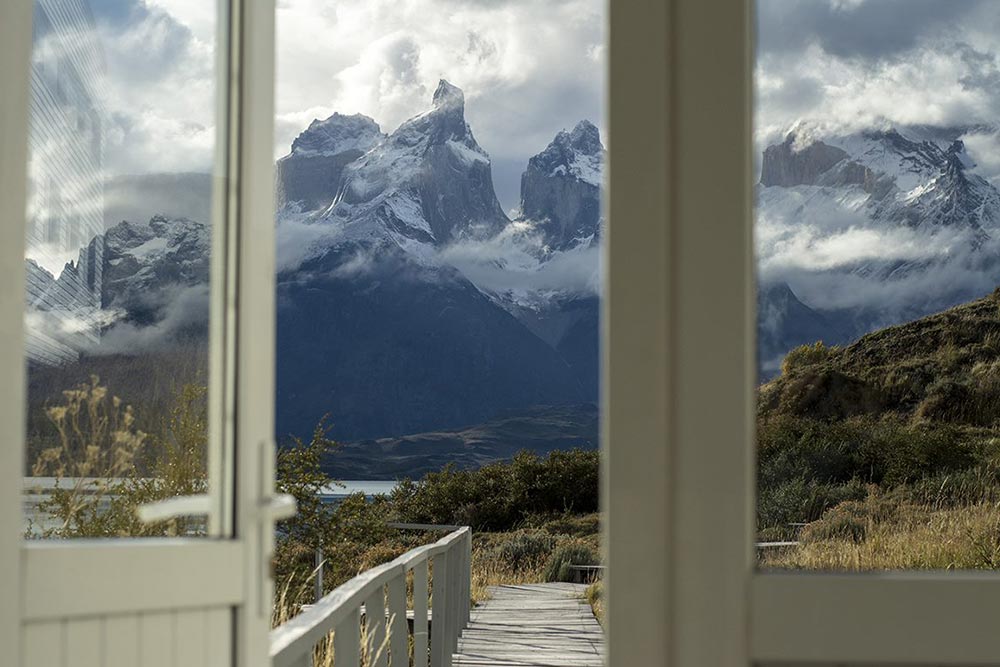
Step right out into nature at Explora’s lodge in Torres del Paine National Park. Photo: Explora
Best bang-for-your-buck hotels
Patagonia Camp is right in the sweet spot: a huge savings from the region’s ultra-spendy adventure lodges, and far more intimate—and closer to nature—than the three- and four-star alternatives. There are 20 yurts on the property. If you can spend a bit more, opt for one with a private jacuzzi on the balcony; of these, yurts 19 and 20 have entirely unobstructed views, but are still nicely secluded. Of the standard options, 4 and 5 are also more private.
Estancia Cerro Guido is Torres del Paine’s newest lodging option. Well, it’s actually the oldest, as it has been a working estancia for eons, but with a recent renovation the family is now operating it as a lodge as well. For those looking for an exceptional lodging experience that is authentically Patagonia—not to mention an incredible value (for the moment!)—Guido is the choice. The excursion offering is fairly robust and includes plenty of riding options, as well as culturally focused and estancia-oriented options, in addition to hiking and wildlife/scenery outings. The views from the common spaces are expansive and include both the Towers and the Paine Massif mountains. While combining two lodges often means the loss of a day of excursions and a lot of additional transport and cost, Cerro Guido pairs easily with Patagonia Camp.
Dishes to try
Sandwiches are the apple pie of Chile. Live like a local and order a lomo Italiano at the counter at Fuente Alemana in Santiago. With shaved pork as high as the Andes and what seems like pounds of palta (Chilean guacamole), tomatoes, and house-made mayo wrapped up in a crusty roll, this sandwich is not for the faint of heart. The name comes from the red, green, and white of the ingredients—just like the Italian flag. If you want a full entrée, the corn pie or Pastel de Choclo is a Chilean favorite, with abundant portions of beef or chicken, onions, a hardboiled egg, and an olive, covered by a corn mash and baked like a shepherd’s pie. Add fresh tomato on top, or do the local thing and sprinkle sugar too. You won’t leave hungry.
Meal worth the splurge
Chef Sergio Barroso has long been a centerpiece in Santiago’s food scene with his past venture, 040, which closed in the wake of social upheaval and the pandemic. This Spanish chef, whose upbringing included time working at the mythical El Bulli, is back with Olam, located in Santiago’s financial and business district, El Golf. Chile’s vast coast and rich seafood resources are the headliners in this new project, which is also the first accredited zero-waste restaurant in Latin America. Barroso also leans on indigenous preparations and relies on his intense use of textures, flavors, and presentations to create a unique dining experience. Make a reservation here well in advance.
Restaurants the locals love
Chile has many picadas, which are essentially no-frills watering holes; the best of them become the center of the local community. Kiosko Roca has for eons been the heart of Punta Arenas, beloved to Magallanicos (the local people). Going there is really about the people—not the food—but try a traditional leche con platano (a banana milkshake) and a choripån (think of it as a Chilean hot dog). They also have a new location in Santiago Centro.
For a sit-down favorite that has a great list of local dishes, lots of local flair, and a diverse wine list, Liguria never fails. They have a few locations throughout Santiago; Manuel Montt or Lastarria are favorites.
The souvenir
Chilotes (residents of the Chiloe Archipelago) are renowned for their fine telares, or woolen handicrafts. Find them at the markets in the main town of Castro, and in nearby Dalcahue, which is a bit farther off the beaten path. The most intriguing pieces depict spirits from the local animist faith.
Best Times to Go
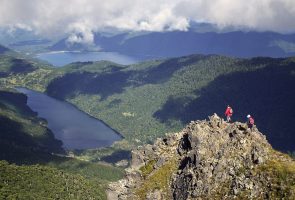
Chile is roughly twice the length of California, so it covers vast latitudes and corresponding climates. March and mid-November through mid-December see the best weather throughout the country: warm temperatures in Patagonia, dry days in the Lakes District, and no oppressive summer heat in central Chile or Easter Island. You’ll also avoid high season, which picks up before Christmas and lasts through February.
The Atacama Desert is a year-round destination.
Worst Time to Go
May through August isn’t optimal in most of the country (unless you want to ski): It’s chilly and rainy in the Lakes District; cold and snowy in Southern Patagonia, and warmer but overcast around Santiago and wine country.
Biggest Rookie Mistake
People underestimate the distances between Chile’s major sites—and thus the time needed to visit them. To properly see the Atacama Desert and Patagonia, for example, you need almost two weeks; this includes at least four nights in Atacama, so that you have time to acclimate to the altitude, and a night in between, since schedules usually don’t allow you to fly from one to the other on the same day. Similarly, Easter Island is a nearly six-hour flight from Santiago, so you’ll want to spend at least three nights if you go. It’s also logistically cumbersome to fly between Chile and Argentina: Even places that look close on a map often require flight routings through each country’s capital.
Airport Intel
Chile is pretty picky about any foods brought through customs—especially fruit, nuts, and dairy. To avoid inspections that can last up to two hours, finish those snacks before you land.
Santiago’s airport has been expanded to include a new international terminal, offering a greater variety of restaurants and dining (when they will get their liquor licenses is a different story). The bathroom density in the arrivals area is rather low, though, so try to get off the plane fully relieved before starting the often long customs and baggage-claim process.
Tipping Tips
Hoard small bills! Large denominations are hard to break, and it can feel awkward to ask for change when tipping a driver or guide.
Check your restaurant bill to see if it already includes a tip; if not, leave 10%.
Don’t Forget to Pack
A bandana or Buff is great for keeping the hair off your face and the wind off your neck.
Vaseline or a thick lip balm is unexpectedly versatile: Use it on sunburnt lips from the altitude in Atacama, chapped hands from the winds of Patagonia, or that backpack zipper that gets stuck on the first day of the trip.
In addition to a rain jacket, bring a cheap rain poncho that you can throw over your backpack if you’re caught in the rain.

